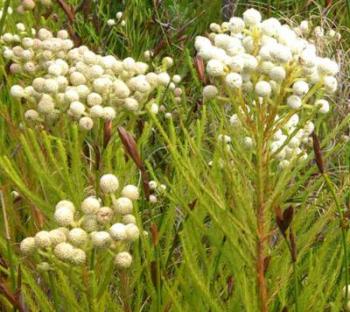Berzelia abrotanoides
Berzelia abrotanoides (L.) Brongn.
Family: Bruniaceae
Common names: redlegs (Eng.); rooibeentjies, vleiknoppiesbos, kolkol, fonteinbos (Afr.)
Introduction
Berzelia abrotanoides is a distinctive and beautiful, softly textured shrub endemic to the Western Cape. Displays of masses of fluffy ball-like flower heads in early summer make it an interesting and pretty addition to a fynbos garden.

Description
Description
Berzelia abrotanoides is a densely leaved, erect shrub, growing to approximately 1.5 metres. The leaves are narrow, softly textured and crowded densely on slender, branching stems. Many tiny cream to white flowers are clustered together, forming rounded flower heads produced on prominent red, often fleshy peduncles. Each flower head is 10 mm in diameter and the stamens protruding from the flowers create a fluffy ball appearance. The flower heads occur en masse on the tips of the branches in late winter to early summer (August-November).

Conservation Status
Status
According to the Red List of South African Plants, Berzelia abrotanoides has been given an automatic status of Least Concern (LC).
Distribution and habitat
Distribution description
Berzelia abrotanoides occurs in flat damp places and seepages, along stream sides and in marshes in the Western Cape. It can be found from the Silvermine plateau to the southern end of the Cape Peninsula. Like B. lanuginosa, B. abrotanoides is a clear indicator of moist areas.
Derivation of name and historical aspects
History
The family Bruniaceae, of which Berzelia abrotanoides is a member, is one of the distinctive families in the Cape fynbos flora and is mostly endemic to the Western Cape. There are 12 species in the genus Berzelia, which was named after Count Jacob J. Berzelius, a Swedish chemist, physician and founder of chemical symbols. The species name, abrotanoides, is derived from abrotanum, resembling or having a similarity to Artemisia abrotanum. Members of the Bruniaceae family with similar flower heads are Brunia and Nebelia.
Ecology
Ecology
Berzelia species are pollinated by bees, flies, beetles and other crawling insects. Occurring within fynbos, a naturally fire-driven system, Berzelia species are able to resprout after fire, coppicing from lignotubers.

Uses
Use
There are no known medicinal or magical uses recorded for Berzelia abrotanoides, however as a garden plant, it adds interest and is beautiful in mixed fynbos beds. It is also suitable for planting in moist areas and on the edges of ponds and streams. Berzelia species are also used in the cut-flower industry and make long lasting additions to fynbos flower arrangements.
Growing Berzelia abrotanoides
Grow
Grow Berzelia species in a well ventilated, semi-shaded to fully sunny position amongst other moisture loving fynbos species. They do best in acidic soils that are moist but well-drained. The soils should contain organic matter such as compost or leaf mould. Berzelia abrotanoides is fairly hardy, but water the plants well during dry seasons. After flowering, prune them lightly to maintain and encourage a compact bushy growth form.
Berzelia abrotanoides is propagated by seed and cuttings. Seed is sown in early autumn (February to March) and should be treated with smoke extract before sowing. Seed trays must be kept moist and shaded.
Cuttings are made in late summer, autumn and spring. Semi-hardwood and softwood cuttings are made in a medium of 50% bark and 50% polystyrene. Slightly coarse sand is also used as a rooting medium. A rooting hormone is used and cuttings are placed in a greenhouse with hotbeds and overhead intermittent mist spray. Once rooted, the small plants can be planted into pots and kept in a shaded area to harden off and establish before being placed in the garden.
References
- Brown, N.A.C. & Duncan, G.D. 2006. Grow fynbos plants. A practical guide to the propagation and cultivation of plants from some of the major families of the Cape Floristic Region of South Africa. South African National Biodiversity Institute, Kirstenbosch, Cape Town.
- Goldblatt, P. & Manning, J. 2000. Cape plants. A conspectus of the Cape flora of South Africa. Strelitzia 9. National Botanical Institute, Pretoria.
- Jackson, W.P.U. 1980. Wildflowers of the fairest Cape. Howard Timmins, South Africa.
- Leistner, O.A. (ed.). 2000. Seed plants of southern Africa: families and genera. Strelitzia 10. National Botanical Institute, Pretoria.
- Smith, C.A. 1966. Common names of South African plants. Memoirs of the Botanical Survey of South Africa No. 35.
- Trinder-Smith, T., 1980. A guide to the flora of the South Western Cape . Howard Timmins, South Africa.
- Voget, C. (ed.). 1998. Grow South African plants. A gardener's companion to indigenous plants. Kirstenbosch Gardening Series. National Botanical Institute, Cape Town.
Credits
Victoria Wilman
Millennium Seed Bank Partnership
December 2012
Plant Attributes:
Plant Type: Shrub
SA Distribution: Western Cape
Soil type: Sandy, Loam
Flowering season: Spring, Winter
PH: Acid, Neutral
Flower colour: White, Cream
Aspect: Full Sun, Afternoon Sun (Semi Shade)
Gardening skill: Average
Special Features:
Horticultural zones







Rate this article
Article well written and informative
Rate this plant
Is this an interesting plant?
Login to add your Comment
Back to topNot registered yet? Click here to register.